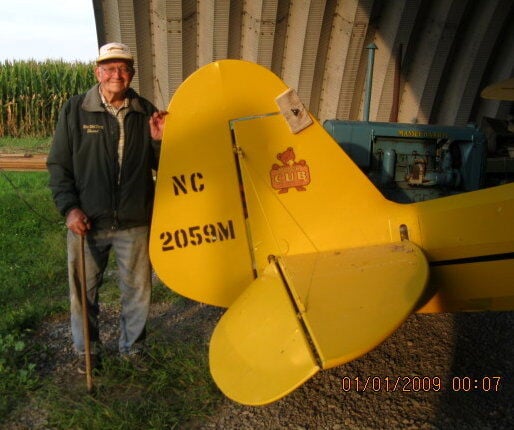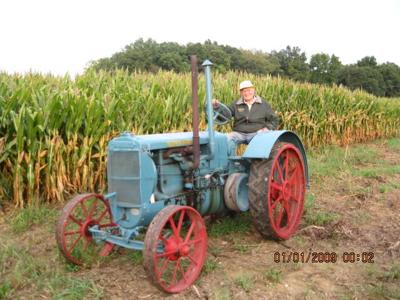Every summer, Elwood Homan drives a piece of history from his home in Pennsylvania Furnace to nearby Ag Progress Days.
While Homan’s 1933 1220 Wallis tractor is historic in its own right, the vintage machine is also carrying history when it heads to the show in Rock Springs.
Homan, who turned 100 in July, still resides in the farmhouse in which he was born. “I moved one bedroom away from the room I was born in. I guess I just can’t leave,” he said.
While his roots run deep on the family farm, which is now operated by his son, Homan’s ties to the Wallis tractor are just as entrenched.
Homan’s father, Sam, purchased the tractor in 1933 to replace the first tractor on the farm — a 1926 Fordson. At the time, there were several Wallis tractors in the area and they were sold through a nearby Massey Harris dealer, Homan said. With 210 acres to plow, the Fordson just wasn’t efficient and horses were being phased out of the agricultural landscape.
“It was a big difference when we went from horses to a tractor. We used to keep three teams and have two hired men to help with plowing,” Homan said. “But even after my dad got a tractor, he insisted on keeping a team of horses to do jobs he said a tractor couldn’t do, like plant corn.”
It didn’t take long, however, for the Wallis to prove its worth. Equipped with a set of two-bottom, 14-inch plows, the 12-horsepower Wallis turned over acres of ground for years on the Homan farm.
“My dad could plow 8 acres a day with it. He was so proud,” Homan said.
“It was a wonderful tractor and never gave us any trouble. The wet clutch was so smooth you could move an inch at a time without jumping.”
After several years of hard plowing and harrowing, the Wallis was taken to a mechanic for an overhaul. According to Homan, the mechanic ground the valves and then stopped.
“He came to my dad and said it would be a mistake to tear that tractor down. There’s nothing wrong with it,” Homan said. “Ever since then, all we’ve done to it is replace the fan belt.”
For all of its attributes, the steel-wheeled Wallis did have one shortcoming: it was too low for a cultivator.
In 1941, Homan’s father traded in the Wallis on a new Allis-Chalmers WC and a cultivator from a dealer located at what is now the entrance to Ag Progress Days. Homan said the family was sad to see the Wallis leave, but the absence didn’t last long.
Changing Times Call for Changing Machinery
That same year, Homan said, his family was timbering the woods on their farm and using horses to drag the logs to a nearby mill. The horses couldn’t keep up with the demand from the mill, he said, and the Wallis was still sitting on the dealer lot.
“We bought it back that same year — a month after we traded it — so we could get the logs to the mill faster,” Homan said.
After the lumbering was finished, Homan parked the Wallis in a shed where it sat for several decades. In the meantime, the farm went through another major transition in 1946 when one of the horses representing the last team on the farm had to be put down after being struck by a car.
At that time, Homan was running the farm and milking cows, and despite his father’s insistence, he yearned to run the operation completely with tractors.
“Everyone was switching to tractors at that time, and with only one horse left I figured now was the time to get out of horses, so I sold it,” Homan said. “I was milking one day and my dad came into the barn and said he’d been looking all over for another horse. I told him I sold the other one, and he was mad. He said you just can’t farm without horses.”
But there was no reversing the trend, and over time Homan added several John Deere tractors to the farm and never kept another horse.

In addition to his 1933 Wallis tractor, 100-year-old Elwood Homan also owns a 1946 Piper J3 Cub. Homan had his pilot’s license since the 1950s and actively flew until he was 90. He and his wife, Ailene, belonged to the Flying Farmers and she was national president at one time.
While the era of farming with horses was largely gone, a relic from the past remained on the farm. The Wallis still sat in the shed, forgotten until Homan was asked to display the tractor at the antique machinery show at Ag Progress Days.
Despite always being a dependable machine, the fenders had rusted off and a paint job was needed. Homan had new fenders built and he painted the tractor to get it ready for the first show in 1975.
That same year, he began making the annual trek to Ag Progress Days on the seat of the Wallis tractor that his father purchased in 1933.
Yet there was just one more update needed for the tractor.
“It was rough driving it on the road with the big steel wheels. I took the cleats off and cut the beads off a set of tractor tires to make them flat, and they fit right on the steel wheels,” Homan said. “You still don’t want to drive it too fast or it’ll jar your kidneys out, so I just take my time driving it while my son (Wayne) follows behind me on his Gator.”
The Wallis has been a part of Homan’s life for 89 of his 100 years, and the two of them haven’t missed a trip to Ag Progress Days.
It is a trip he intends on making every year.
“If I’m still living and they want me to bring the Wallis over, I’ll keep doing it,” Homan said. “When we crank it up and I climb onto the seat, it brings back a lot of memories.”



